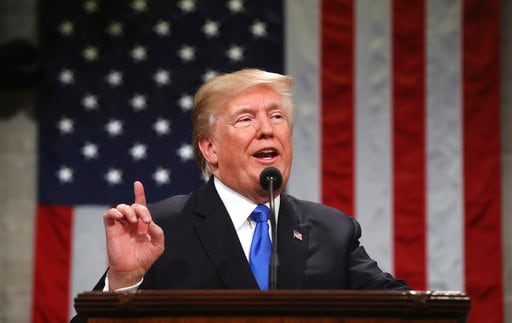WASHINGTON — President Donald Trump, in his first State of the Union, asked Congress to “fully fund” the U.S. military, but he will have to navigate the Capitol Hill cross-currents that bedeviled the last administration.
Making his case, Trump acknowledged that America faces “rogue regimes, terrorist groups, and rivals like China and Russia.
“In confronting these dangers, we know that weakness is the surest path to conflict, and unmatched power is the surest means of our defense,” Trump said. “For this reason, I am asking the Congress to end the dangerous defense sequester and fully fund our great military.”
Sequestration, the enforcement mechanism for discretionary spending caps, has become publicly despised in Congress — and yet lawmakers have been unable to get rid of it. Instead lawmakers have taken to easing the caps for massive omnibus appropriations.
And Trump faces congressional dynamics that seem to have only gotten less friendly and more gridlocked in recent weeks.
RELATED

On Tuesday, Senate Majority Leader Mitch McConnell, R-Ky., and Senate Minority Leader Chuck Schumer, D-N.Y., told reporters they’ve made good progress in negotiations for a 2018 ominbus, but offered no details.
The new wrinkle in budget negotiations this year is that they are complicated by Democratic demands for a fix for immigrants who were brought to the country illegally as children.
In his speech, Trump offered a compromise that included funding for a wall on the U.S.-Mexico border, but his remarks drew boos from Democratic lawmakers.
Candidate Trump campaigned on ambitious plans for a military buildup to 355 ships, 1,200 Air Force fighter jets and thousands more Marines. Since, Defense Secretary Jim Mattis has said in Capitol Hill testimony that those plans require sustained defense spending growth through 2023.
Notably, Trump made no mention of any of that in his address Tuesday. Instead, he focused on nuclear weapons, saying, “we must modernize and rebuild our nuclear arsenal, hopefully never having to use it, but making it so strong and so powerful that it will deter any acts of aggression by any other nation or anyone else.”
A government report predicted Obama-era plans to upgrade the U.S. nuclear arsenal would cost $1.2 trillion over 30 years. An early peek at Trump’s plans show them as more expansive, with controversy swirling around plans to develop low-yield tactical weapons.
RELATED

Hawkish Republican lawmakers assert there is broad support for more defense spending — as evidenced by the passage of a National Defense Authorization Act that authorizes $700 billion for defense — but Democrats have continued to insist any increase for defense be matched on the non-defense side, dollar-for-dollar.
That impasse has yielded four stop-gap continuing resolutions, as Congress has kicked the can now four months into fiscal 2018.
Democrats have negotiating leverage because, under the 2011 Budget Control Act, the spending package needs 60 votes to ease budget caps and pass the Senate. That means at least eight Democrats in the upper chamber have to defect.
And on Tuesday, House Republicans were not taking the compromise route. They voted to pass a stand-alone defense appropriations bill, putting the deadlock and ideological divisions on full display.
Democrats have largely stood firm, calling on Republicans to negotiate a long-term budget agreement that works for the entire federal budget.
“Democrats strongly support robust funding for our military, and we agree with Pentagon leaders who have said that budget uncertainty hinders military planning and readiness — but it also damages every other government agency as well,” the House’s No. 2 Democrat, Rep. Steny Hoyer, of Maryland, said Tuesday. “Both defense and non-defense programs are critical to our national security. Non-defense priorities include homeland security, law enforcement, and our diplomats working to secure our interests around the world.”
The fiscally conservative House Freedom Caucus is signaling openness to funding certain domestic priorities, like infrastructure—as Trump touted in his State of the Union speech—but the group is far from increasing defense and domestic spending at the same rate.
“Let’s make sure we’re not growing the size of government faster than the inflation rate,” North Carolina Republican Rep. Mark Meadows, who chairs the House Freedom Caucus told reporters Tuesday. “If we had an inflation rate of a little over 2 percent, why should government grow at a rate of 13 percent.”
With the appropriations vote, Republicans are calculating that Democrats’ refusal to approve stand-alone defense appropriations will create internal divisions and hurt them in midterm elections. There are 10 Democratic senators running for re-election in states that Trump carried in the 2016 election.
If there is an opening for greater defense spending, that might be it, according to Rep. Tom Cole, a senior Republican appropriator and leadership ally. He suggested Democrats are sensitive about being blamed for this month’s three-day government shutdown.
“I think it’s getting harder and harder for Democrats in red states who are on the ballot to be voting against this,” Cole said of the House defense appropriations bill. “You’re holding up funding for the military on unrelated issues, and I think if the Democrats aren’t careful, they’ll find themselves in the same place they were in on the government shutdown.”
It’s in this environment that Trump will reportedly request a total Pentagon top-line of $716 billion for 2019 next month, a significant increase over the caps and also over Trump’s own request for 2018.
As large as it sounds, that number signals more of Defense Secretary Jim Mattis’ responsible growth plans and not the promised buildup, according to Mackenzie Eaglen of the conservative American Enterprise Institute.
“The increased money for readiness, people and lethality is moving through the system but because the focus is less on modernization, it will be manifest in smaller, less tangible ways, especially to lawmakers,” Eaglen said.
To attain buildup-level increases, Republicans must reach a compromise with Senate Democrats on other budget and policy issues, or Senate Republicans can unilaterally change their rules — the so-called “nuclear option” — and ram a budget deal through with only Republican votes.
“Both options are fraught with political risks,” said defense budget analyst Todd Harrison, of the Center for Strategic and International Studies. “The alternative is we continue to stumble along from year-to-year with extended CRs, last-minute deals, and continued uncertainty.”
“I feel like Bill Murray in the movie ‘Groundhog Day,’ ” Harrison said. “It seems like it is basically the same situation every February for the past six years. Like President Obama, President Trump can keep requesting more than the budget caps allow and continue making the argument that the military needs more resources.”
Joe Gould was the senior Pentagon reporter for Defense News, covering the intersection of national security policy, politics and the defense industry. He had previously served as Congress reporter.







